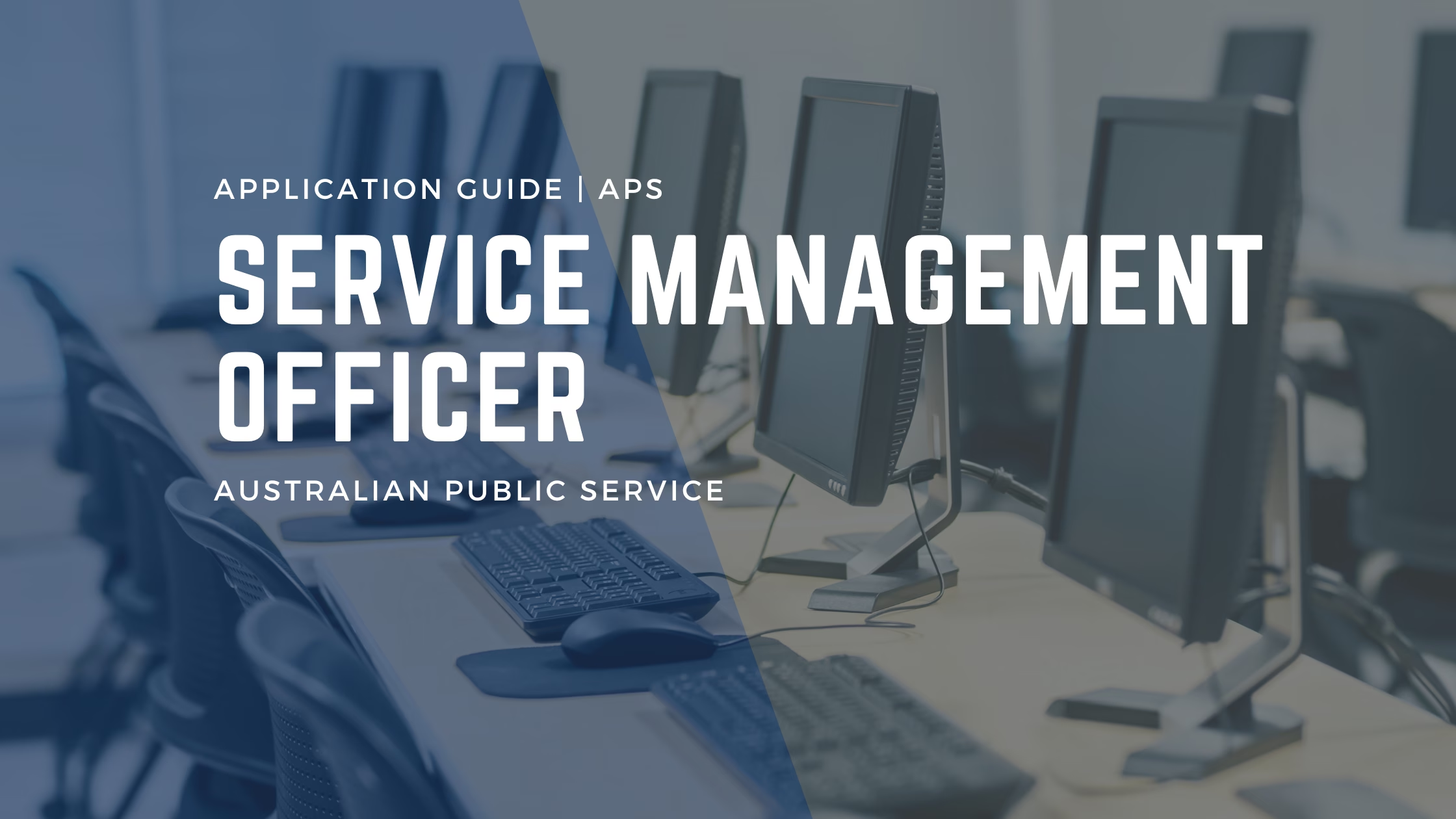Looking to land your next APS6 role in the ICT space? The APS6 Service Management Officer role at NDIA offers a rare opportunity to join one of the most significant social reform agencies in Australia. With a national footprint and a commitment to innovation in public service ICT delivery, this position is ideal for candidates looking to grow their career in ICT service governance, change management, or problem resolution.
Here’s why this job stands out: a strong focus on ITIL4-based service management, flexible work arrangements, and a supportive culture driven by purpose and inclusion. This post includes a fully written example APS pitch tailored to the role.
If you’re applying for APS roles, check out this free APS application template pack.
Table of Contents
APS6 Service Management Officer Salary and Overview
| Position Title | APS6 Service Management Officer |
| Organisation/Entity | National Disability Insurance Agency (NDIA) |
| Job Location | Any NDIA Office (remote may be considered) |
| Work Type | Ongoing or Non-ongoing (up to 12 months, extendable) |
| Base Pay | $96,737 – $106,950 + 15.4% superannuation |
| Closing Date | 18 June 2025 – 11:30 PM (AEST) |
About the APS6 Service Management Officer at NDIA
The APS6 Service Management Officer supports NDIA’s Enterprise Architecture and Governance Branch by delivering high-impact ICT Service Management functions. This includes ITIL4-based practices such as Change Enablement, Problem and Release Management, and Service Level Management. The team ensures robust service delivery, collaboration, and problem-solving across the agency.
Success in this role requires managing complex service processes and stakeholder engagement in a fast-paced, evolving environment. You may facilitate the ICT Change Advisory Board or coordinate post-implementation reviews and root cause analysis. The biggest challenge? Keeping systems agile and compliant while supporting the NDIA’s broad national mission.
Why APS6 Service Management Officer is a Great Opportunity
This is a great opportunity for someone with a proven IT background to get into the public sector at a senior level.
- Multiple opportunities across Australia
- Ongoing and temporary roles available
- National impact and meaningful work aligned to participant outcomes
- Above-market superannuation and remote/hybrid flexibility
- Clear pathways for professional development in service design and management
- Supportive, diverse work culture within a high-performing team
Application Requirements for APS6 Service Management Officer
APS6 Service Management Officer Application Process
To apply, you’ll need to submit:
- A resume
- A succinct APS pitch (maximum 500 words) quoting job reference 1566_05/25_EXT
If you’re not sure where to start, download our free APS cover letter template.
What to Include in Your APS6 Pitch for Service Management Officer at NDIA
Use your 500-word pitch to show how your experience aligns with the NDIA’s service management objectives. Use clear STAR examples to demonstrate your impact, and aim to address as many of the following areas as possible:
- Adaptability: Describe how you’ve embraced change, tackled challenges, and investigated issues with an open mind and a positive attitude.
- Self-Motivation: Demonstrate a commitment to continuous learning and improvement, and show how you’ve contributed to a motivated, results-focused team.
- Effective Performance: Provide examples of how you manage time and resources efficiently, prioritise effectively, and deliver quality outcomes that add value for stakeholders.
- Engagement: Highlight how you communicate well with both technical and business stakeholders and work collaboratively with teams, partners, and customers.
- Technical/Professional Knowledge: Mention relevant qualifications (e.g. ITIL4 Foundation) and your experience in ICT Service Management environments.
- Career Focus in ICT Service Management: Show your interest in building a career in ICT Service Management. Demonstrate curiosity, problem-solving skills, and a desire to grow in this field.
- Technical Proficiency: Reference your skills in tools commonly used in ICTSM environments—such as Microsoft 365, Teams, Visio, and SharePoint. If relevant, also mention coding, system administration, database or BI tools.
Tip: A well-chosen STAR example can address multiple criteria in one story—focus on relevance and results.
APS6 Service Management Officer Application Checklist
| ✅ | Read the full NDIA job ad carefully |
| ✅ | Draft your APS pitch using a free template |
| ✅ | Use STAR examples to show how your experience aligns with the role. |
| ✅ | Get your APS pitch reviewed by an expert |
| ✅ | Submit your application before 18 June 2025 via NDIA Jobs Portal |
Candidate Profile For APS6 Role
Meet Marcus: a senior ICT support officer in the federal government with five years’ experience. He recently led a change enablement initiative and holds an ITIL4 certification. Marcus wants to transition into a strategic ICT Service Management role and sees this NDIA position as the perfect fit. He values NDIA’s mission, the opportunity to work on meaningful projects, and its support for flexible working.
Example Pitch for APS6 Service Management Officer
GET YOUR OWN APPLICATION STARTED QUICKLY WITH THIS FREE TEMPLATE
I am a senior ICT professional with five years of experience in the Australian Public Service, currently working as an ICT Support Officer. I am ITIL4 Foundation certified and have recently led a successful change enablement initiative—experience that has strengthened my interest in transitioning into a more strategic ICT Service Management (ICTSM) role.
Throughout my career, I’ve demonstrated a strong commitment to continuous improvement and collaboration. In my current role, I’m responsible for triaging and resolving complex technical issues, engaging with users across different business units, and supporting system upgrades and service transitions. I recently took on a lead role in coordinating a change enablement project to reduce service disruption during scheduled deployments. This involved engaging with both business and technical stakeholders to map current processes, identify friction points, and introduce a revised communication and approval flow. The result was a measurable drop in incident volume during change windows and stronger internal stakeholder confidence in our ICT team.
This experience highlights both my adaptability and stakeholder engagement capabilities. I worked across teams with competing timelines and service expectations, and used a structured, empathetic approach to gain buy-in for new processes. I also ensured that solutions aligned with business needs—not just technical standards. This is something I’ve learned to prioritise: balancing operational requirements with user impact.
My work style is proactive and highly organised. I’m often the first point of contact for major service issues, where I need to assess urgency, allocate resources, and communicate status updates clearly and calmly. I’ve developed tools in SharePoint and Excel to help manage knowledge, support documentation, and internal workflows. I also provide input into team performance reports and identify patterns in service data that can inform improvements—demonstrating my analytical thinking, effective performance, and growing interest in ICTSM strategy.
I take pride in maintaining strong technical proficiency. In addition to Microsoft 365, Teams, and SharePoint, I have experience supporting service desk platforms and working closely with database administrators and system analysts to manage escalations. I’m also developing my skills in Power BI to better interpret and present service metrics, which I see as key to adding strategic value in a future ICTSM role.
What draws me to the NDIA is not just the scope of the role, but the purpose behind it. The agency’s work matters, and I’m motivated by the opportunity to support service delivery in a way that improves outcomes for people with disability. I’m also drawn to NDIA’s strong culture of inclusion, flexibility, and growth.
This role represents the next step in my career—combining my service management experience, user-centred approach, and leadership potential in a setting where I can contribute to both operational performance and meaningful outcomes.
How to Use the STAR Method in Your APS6 Application
When applying for APS6 roles—like this ICT Service Management position at the NDIA—using the STAR method is essential for showcasing your experience in a structured and compelling way. STAR stands for:
- Situation – What was the context?
- Task – What was your responsibility?
- Action – What steps did you take?
- Result – What was the outcome?
Here’s how Marcus applied the STAR method in his pitch:
Leading a change enablement initiative (Adaptability, Engagement, Technical/Professional Knowledge)
- Situation: Service disruptions were occurring during scheduled ICT deployments.
- Task: Lead a change enablement project to reduce these disruptions.
- Action: Engaged stakeholders, mapped friction points, introduced a revised communication and approval flow.
- Result: Reduced incident volume and improved stakeholder confidence.
When writing your own APS6 pitch, use STAR examples like this to directly demonstrate how you meet the role’s core capabilities. Focus on real results, clear actions, and measurable impacts to help your application stand out from the crowd.
Need help crafting your STAR examples? Start by drafting your APS pitch and then send it in for a review. I’ll make sure your experience aligns with government requirements.
Get Your APS6 Service Management Officer Application Ready
To get started, review all the details available in the job ad and candidate information pack.
Then, start applying online and start writing your draft pitch using the free APS template.
When you’re ready, get your APS application reviewed. You’ll know then that you have taken every possible step to put forward your best application, improving your chances of getting shortlisted.




